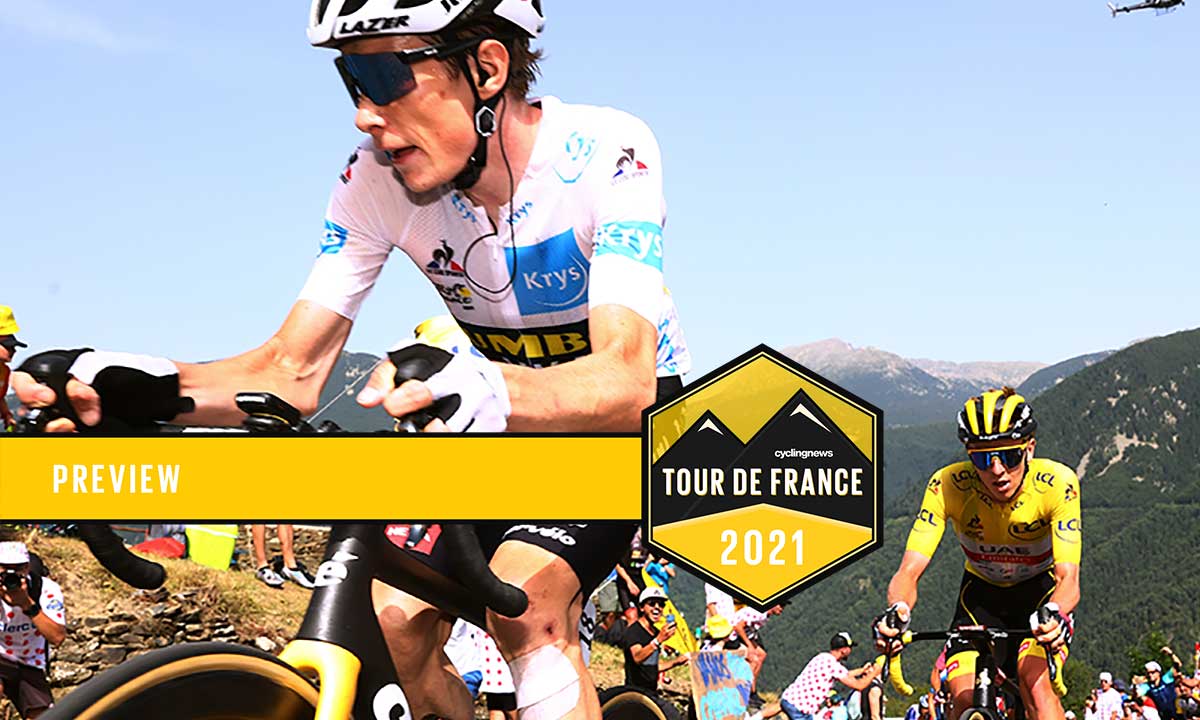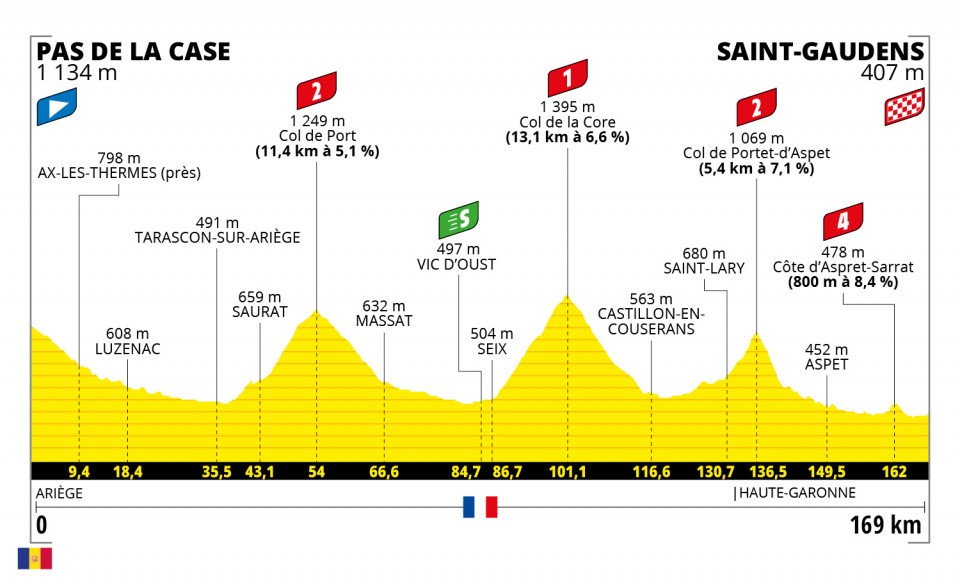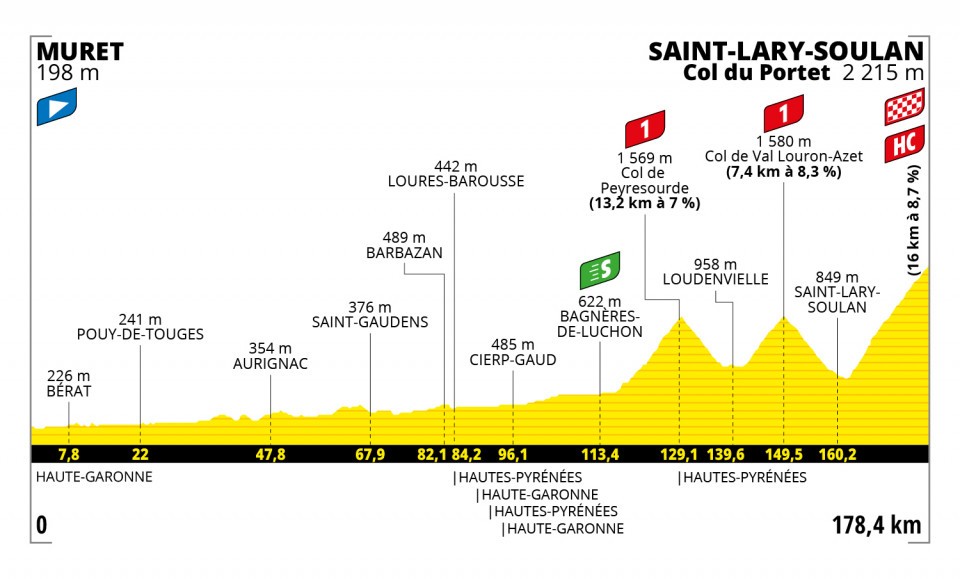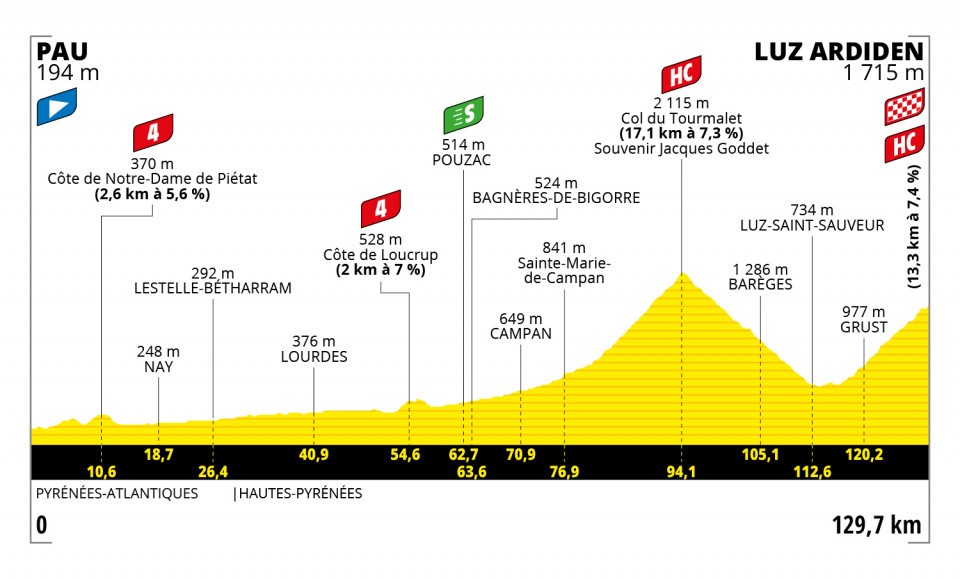Tour de France endgame beckons in the Pyrenees - Preview
Challenges to Pogacar's dominance and for the final podium to play out on Col du Portet, Luz Ardiden

The second week of the Tour de France was always likely to struggle to match the drama of its tumultuous opening, and so it proved. While the intensity remained high – witness, for instance, the opening hour of stage 14 – the general classification took on a rather more fixed appearance. The current top four overall are pretty much where they found themselves a week ago.
When the Tour reached Tignes on stage 9, Tadej Pogačar (UAE Team Emirates) held a lead of 5:18 on Rigoberto Uràn (EF-Nippo), 5:32 on Jonas Vingegaard (Jumbo-Visma) and 5:33 on Richard Carapaz (Ineos). At the end of stage 15 in Andorra, those time gaps remained precisely the same.
Vingegaard had provided a frisson with his defiant attack atop Mont Ventoux, but that day ended, like every other, with Pogaçar, Urán and Carapaz all finishing in the same time as the Dane.
As the race enters its third week, it seems unclear if anybody can threaten Pogačar’s hegemony. Vingegaard made inquiries on the Ventoux but Pogačar responded quite firmly on the Col de Beixalis on Sunday. The nagging question over the strength of Pogačar’s UAE Team Emirates guard, meanwhile, has been rendered moot thus far, by a combination of the yellow jersey’s own strength and the curious tactics of Ineos, who have effectively done his bidding by controlling the race on set-piece stages.
It is equally uncertain if anything between now and the time trial to Saint-Émilion on Saturday can truly separate the men contending for a podium spot in Paris. There has been some movement – Ben O’Connor (AG2R-Citroën) slipped from second to fifth, and Guillaume Martin (Cofidis) briefly put himself in the hunt – but Vingegaard, Uràn and Carapaz have broken even, while Wilco Kelderman (Bora-Hansgrohe) lost ground on them on just one day, over the Ventoux.
Kelderman, for his part, reckoned that the final week would provoke rather more changes on GC than the second, citing, in particular, the presence of back-to-back summit finishes, on the Col du Portet on stage 17 and at Luz Ardiden the following afternoon. ASO shied away from summit finishes this year, apparently in a bid to maintain suspense, but the decision has had unintended consequences. This Tour would have a slightly different feel, for instance, had the clock stopped atop Mont Ventoux on stage 12 when Vingegaard was 37 seconds clear of Pogačar.
Three successive days of climbing in the Pyrenees might yet reignite this race, even if it’s hard to shake off the sense that Pogačar has already long since snuffed out the contest for the yellow jersey.
Get The Leadout Newsletter
The latest race content, interviews, features, reviews and expert buying guides, direct to your inbox!
The road ahead



The final Pyrenean troika begins with a day that appears to lend itself more obviously to a breakaway than to a GC battle. Then again, given Pogačar’s ease in stifling attacks on the Beixalis, his rivals will surely have realised that it will be difficult, if not impossible, to recoup their hefty deficits on the two following summit finishes. Stage 16 from Pas de la Case to Saint-Gaudens, on the other hand, perhaps offers scope for invention or ambush.
After a fast descent back into France, the peloton faces the category 2 Col de Port (11.4km at 5.1 per cent), which proceeds the day’s intermediate sprint. The tough Col de la Core (13.1km at 6.6 per cent) is next up, and it’s the kind of climb that could rid the yellow jersey of many teammates ahead of the final 60km, though there is time to recoup ground ahead of the category 2 Col de Portet-d’Aspet (5.4km at 7.1 per cent). The summit comes with 33km remaining and the short but steep Côte d’Aspret-Sarrat in the finale could instead prove a springboard for the eventual stage winner.
The podium contenders should dominate on the following two days in the Pyrenees, starting with stage 18 from Muret to the Col du Portet. After a relatively gentle preamble, the bulk of the day’s climbing is shoehorned into the final 60km, and the succession of climbs – not to mention the altitude – will make for a most demanding finale.
Indeed, it’s a near replica of the short, 65km stage that encompassed the Col du Portet on its debut in 2018. The category 1 Col du Peyresourde (13.2km at 7 per cent) begins the winnowing process, and the transition from big to little ring could prove brutal for some. After the rapid descent to Loudenvielle, the road climbs again, this time to the Col du Val Louron-Azet (7.4km at 8.3 per cent).
As in 2018, the race descends to Saint-Lary-Soulan before facing into arguably the most arduous ascent of the entire Tour, the hors categorie Col du Portet, which climbs for 16km at an average gradient of some 8.7 per cent. The briefest of respites midway up at Espiaube aside, the Portet is relentless, with the gradient regularly hitting double digits. The road kicks up beyond 10 per cent in the final kilometre, and altitude could also be a factor, given that the climbs tops out at 2215m. Men like Carapaz and Uràn, who haven’t troubled Pogačar to this point, might feel more optimistic of probing the yellow jersey here.
The Tour’s extended residence in the Pyrenees concludes on stage 18 with an old friend, the Col du Tourmalet, which provides the centrepiece of the 129km leg from Pau to Luz Ardiden. As on the previous day, there is a flat opening half to the stage, with just a pair of category 4 ascents to break up proceedings, and that bodes well for the men worried about making it home inside the time cut.
The stage takes on a different guise in the final 50km, as the road climbs via La Mongie to the hors categorie Col du Tourmalet (11.1km at 7.3 per cent). A long and sinuous descent to Luz-Saint-Sauveur follows before the hors categorie summit finish at Luz Ardiden (13.3km at 7.4 per cent), which returns to the Tour after a ten-year hiatus.
The often mist-shrouded ascent has featured on eight previous occasions, beginning with Pedro Delgado’s victory in 1985. Miguel Indurain delivered an important calling card when he won here in 1990, while Roberto Laiseka scored Euskaltel’s first Tour stage win in 2001.
The Tour’s most notorious visit to Luz Ardiden has, officially, at least, been excised from the records. Lance Armstrong was first across the line in 2003 when he crashed at the base of the climb but then put daylight into Jan Ullrich by the summit. There weren’t quite the same fireworks in 2011 when Samuel Sanchez was the stage winner and Thomas Voeckler began to warm to his improbable adventure in the yellow jersey.
All evidence to this point in 2021 suggests that Pogačar will still be in yellow when the Tour reaches Luz Ardiden on Thursday evening, even if he struck a cautious note during his rest day press conference when he identified the Col du Portet as the week’s most demanding obstacle. “If you have a bad day, any stage can be complicated,” said Pogačar. That much is true, but Pogačar has been making it all look simple thus far.

Barry Ryan was Head of Features at Cyclingnews. He has covered professional cycling since 2010, reporting from the Tour de France, Giro d’Italia and events from Argentina to Japan. His writing has appeared in The Independent, Procycling and Cycling Plus. He is the author of The Ascent: Sean Kelly, Stephen Roche and the Rise of Irish Cycling’s Golden Generation, published by Gill Books.